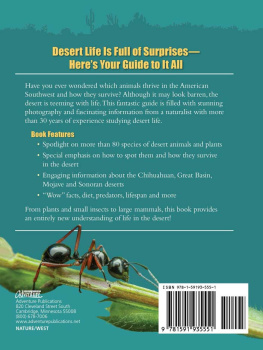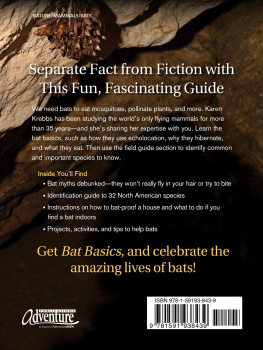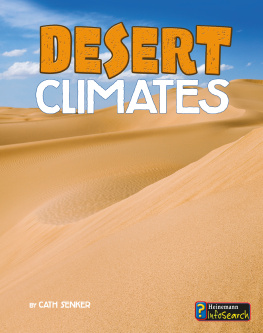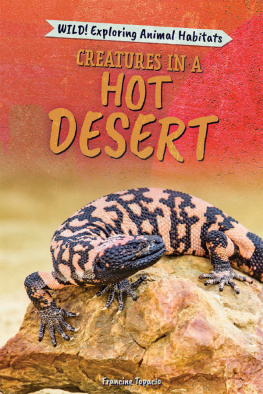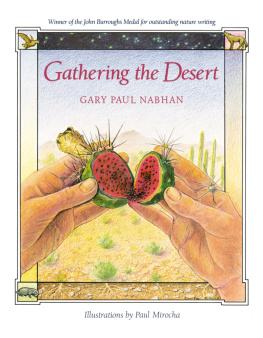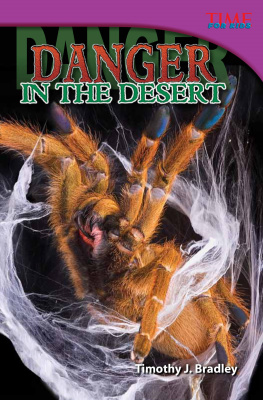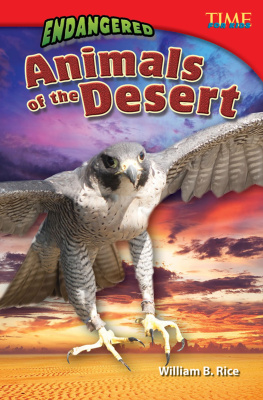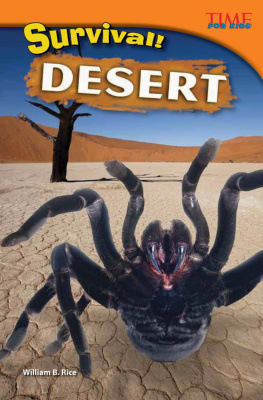
Acknowledgments
My heartfelt thanks to the National Park Service for all of their support over the years with my bird and bat research.
Cover and book design by Lora Westberg
Edited by Brett Ortler
Photo credits:
Rick and Nora Bowers: (Desert Shrew).
All other photos via Shutterstock.
10 9 8 7 6 5 4 3 2 1
Copyright 2017 by Karen Krebbs
Published by Adventure Publications
An imprint of AdventureKEEN
820 Cleveland Street South
Cambridge, Minnesota 55008
(800) 678-7006
www.adventurepublications.net
All rights reserved
Printed in China
ISBN: 978-1-59193-555-1; eISBN: 978-1-59193-664-0
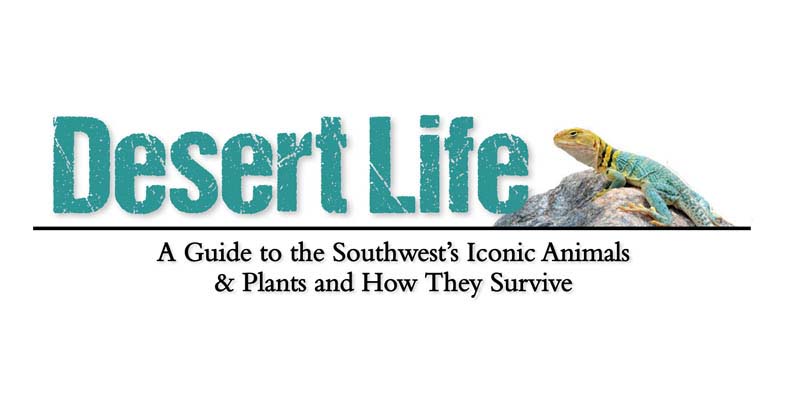
Table of Contents
Desert Life Introduction
If you took a flight over a rainforest, youd be amazed at the beauty and scenery below you. And why shouldnt you be? The rainforest is alive. If the setting changed to a desert, what would you think as you flew over? Many people would probably think they were flying over a barren wasteland. But deserts arent dead; far from it, they are teeming with all sorts of specialized plants and animals. The Sonoran Desert alone boasts more than 500 species of birds, 130 species of mammals, more than 100 species of reptiles, and more than 2,500 plant species.
And if you spend any time in the desert, youll see, hear, or smell evidence of all of this life: Coyotes howl during the evening, owls call out, breezes bring the sweet smell of flowers and plants, and its impossible to miss the towering saguaros, the flowering ironwood trees, and the vivid displays of wildflowers, or the butterflies and hummingbirds zipping from one bloom to another.
This book will introduce you to the deserts of the Southwest and the animals and plants that live in them. Along the way, youll learn about the fascinating survival strategies and adaptations that help these amazing organisms thrive.
What Is a Desert?
Deserts are usually warm and dry, and many receive less than 10 inches of rain a year. A lack of rainfall isnt the only thing that keeps deserts dry; many have very high rates of evaporation, which means that much of the precipitation that falls never actually reaches the ground. This keeps deserts dry and makes rainfall a rarity. Desert soils are also fairly inhospitable; they often consist of sand, salts, clays, or a specific variety of a calcium known as caliche, which can prevent plants and animals from taking up residence in an area.
The Deserts of the Southwest
There are four major deserts in North America. The Chihuahuan Desert is the largest and covers about 175,000 square miles in Mexico, with fingertips in southern New Mexico, southwestern Texas, and the far-flung reaches of southeastern Arizona.
The Great Basin Desert is our second-largest desert and occupies more than 158,000 square miles; it stretches from southern Idaho and the southeastern corner of Oregon to western Utah and much of northern Nevada.
With an area of 106,000 square miles, the Sonoran Desert is the third largest, and it is located in southern Arizona, southeastern California, part of Baja California, and northwestern Mexico.
The Mojave Desert is the smallest desert in the Southwest, at 54,000 square miles. It covers southern Nevada, the southwestern corner of Utah, part of southern California, and a small piece of western Arizona. In this book, we will focus on the Great Basin, the Mojave, and the Sonoran deserts, as they are primarily found in the western United States.
The Great Basin Desert
The Great Basin is the northernmost desert, and it is both the coldest and the largest of our Southwestern deserts. It receives most of its precipitation in the form of winter snow, and it also boasts impressive elevations4,000 feet above sea level on average. On the whole, the Great Basin Desert has fewer plant and animal species than our other deserts; nonetheless, the species found in the Great Basin are often specialized due to the areas unique geology. The Great Basin Desert lies between the Rocky Mountains and the Sierra Nevadas, but this area is not one big basin as its name implies. Instead, it has numerous basins and mountain ranges, as well as a number of isolatedand diversehabitats. The majority of plants found in the Great Basin Desert are grasses or small- or medium-size shrubs (especially sagebrush and saltbushes). In areas where there is standing water, such as near the Great Salt Lake, Pyramid Lake, or Sevier Lake, birds and mammals can be observed, but in drier areas, most of the animals live underground or are difficult to see.
The Mojave Desert
The Mojave is a hot desert; thats actually something of an understatement, as it is home to Death Valley, the site of the hottest temperature ever recorded on the Earths surface, an incredible 136.4 degrees Fahrenheit. Its not always hot in the desert, though; temperatures can occasionally dip into the 30s. Nonetheless, there are normally 200 days or more of frost-free temperatures. The desert receives little precipitation6 inches or less per year. Las Vegas, Nevada, gets even less than that, at 4 inches per year, and Death Valley receives just 2 inches. Most rainfall occurs in winter.
Plant life is usually found in the form of small to medium shrubs, but cacti can also grow here. The Joshua tree is an iconic symbol of the Mojave, and it is seen primarily within the boundaries of the desert. All in all, the Mojave and Sonoran Deserts are inhabited by many of the same plant and animal species, including such plants as creosote bushes, mesquite and barrel cacti, and animals such as lizards, ants, tortoises, Gila monsters, toads, snakes, and birds.
The Sonoran Desert
The Sonoran Desert is also a hot desert, and rainfall occurs in summer and winter. The summer rains often appear as violent, sudden thunderstorms; winter rains are far gentler. Temperatures are hot in the summer, and winters are fairly mild, though freezing temperatures do sometimes occur. Because of its mix of precipitation, the Sonoran is known as a dry-tropical desert, and it is home to more species overall than the other deserts found in the U.S. Many of the plants and animals are similar to those found in the Mojave, but there are some significant differences. Unlike in the Mojave, columnar cacti, including saguaro, organ pipe, cardon, and senita, are common here and produce nectar for pollinators. Reptiles are abundant and easy to spot, and while many of the birds found here can also be observed in other deserts, they can be quite numerous in the Sonoran.
The Indigenous Peoples of the Southwest
Indigenous peoples have lived in the deserts of the Southwest for thousands of years, and theyve produced distinct cultures rich in story, architecture, and art. Despite immense challenges, these cultures are still thriving today. They have survived, in part, thanks to their deep understanding of the ecosystem, the flora and fauna, and the environment.
An array of distinct peoples have lived in the Southwest at one point or another, and the numerous ruins, pueblos, and even irrigation canals in the Southwest attest to their adaptability and skill at surviving in a decidedly hostile environment. Early cultures include the Hohokam, the Mogollon, and the Anasazi, but they suffered profoundly because of the introduction of European diseases, and this led other indigenous peoples to populate the area soon thereafter.
Next page
